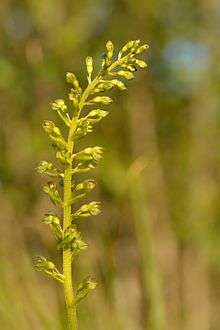Neottia ovata
| Common Twayblade | |
|---|---|
 | |
| Scientific classification | |
| Kingdom: | Plantae |
| (unranked): | Angiosperms |
| (unranked): | Monocots |
| Order: | Asparagales |
| Family: | Orchidaceae |
| Subfamily: | Epidendroideae |
| Genus: | Neottia |
| Species: | N. ovata |
| Binomial name | |
| Neottia ovata (L.) Bluff & Fingerh.[1] | |
| Synonyms[1] | |
| |
Neottia ovata (eggleaf twayblade[2] or Common Twayblade) is a terrestrial orchid widespread across much of Europe, including the British Isles, as well as Siberia, Central Asia, Southwest Asia and the Himalayas.[1] It has been introduced into Ontario, Canada, where it has been called the Eggleaf Twayblade.[3] It was formerly placed in the genus Listera, but molecular phylogenetic studies have shown that Neottia nidus-avis, the Bird's-nest Orchid, evolved within the same group,[4] and the two genera have been combined.
Neottia ovata grows in a variety of habitats: woods, meadows, dune-slacks and moorland. The flowering stems are typically 20–60 cm (7.9–23.6 in) tall, occasionally up to 75 cm (30 in). There are two large opposite basal leaves (hence the common name), 5–20 cm (2.0–7.9 in) long. A variable number of flowers is borne on the stems, usually more than 15 but less than 100. The flowers are small and yellowish-green in colour. The sepals and the two side petals form a fairly open hood, 5–6 mm (0.2 in) long; the labellum or lip (the central petal) is 7–15 mm (0.3–0.6 in) long and is divided at the end into two lobes.[4]
Pollination
The flower of Neottia ovata is well accessible for a wide range of insects. It is above all pollinated by parasitic wasps, sawflies and beetles. The pollinia lie free on top of the gutter-shaped rostellum, an organ that is filled with viscid fluid. When an insect touches the sensitive tip of the rostellum, the viscid fluid is ejected and glues the pollinia to the visitor's body. Fruit set is quite high.
References
- 1 2 3 "Neottia ovata", World Checklist of Selected Plant Families, Royal Botanic Gardens, Kew, retrieved 2012-04-04
- ↑ "Liparis ovata". Natural Resources Conservation Service PLANTS Database. USDA. Retrieved 22 June 2015.
- ↑ "Plants Profile for Listera (twayblade)", USDA Plants, USDA Natural Resources Conservation Service, retrieved 2012-04-05 (as Listera ovata)
- 1 2 Stace, Clive (2010), New Flora of the British Isles (3rd ed.), Cambridge, UK: Cambridge University Press, ISBN 978-0-521-70772-5, p. 864
- CLAESSENS, J. & J. KLEYNEN : The flower of the European Orchid – Form and function, 2011, ISBN 978-90-9025556-9.
External links
| Wikimedia Commons has media related to Listera ovata. |


